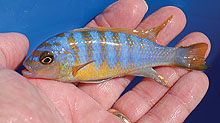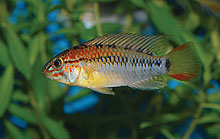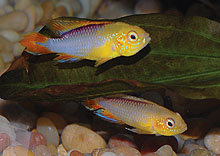WHAT'S NEW ACROSS THE WORLD
Select date in side bar to go to a What's New of previous issues
| What's New
©by Laif DeMason
The doldrums of summer are behind us and the kids are back in school. Until now, most hobbyists are laying back any ideas of new fish purchases until, well, maybe they are inspired by the weather or other hobbyists! Can you import some wild Malawi cichlids they ask…? And yes when we have them, nobody buys any. What about Congo frontosa? Yep have them, but they just sit with no sales as well. What about rare West Africans or Central American cichlids? No takers there either. That’s the fish business…!
Here’s “what’s new” on the cichlid scene: |
Lake Tanganyika
Sad news from Burundi, Jacques Schreyen, one of the founding member of Fishes of Burundi (along with his wife Mireille Brichard Schreyen and his late father-in-law Pierre Brichard), has passed away in early July. Jacques was a most helpful and pleasant person, and a great fish hatchery technician. He also had some fishes named after him. Mireille, unable to run Fishes of Burundi by herself, decided to close the firm after nearly 45 years of operations.
| WHAT'S NEW: LAKE TANGANYIKA |

The demand for Tropheus brichardi varieties run hot and cold for specialty hobbyists, perhaps based on which Youtube video is currently playing. Pictured here a newly imported type of T. brichardi from Mtoto, Congo. This cichlid has a gold-yellow head coloration that often extends into the body.
|

Since Tropheus moorii collections from Linangu/Musanga are currently off limits in Zambia, exporters are looking for a good replacement for this popular yellow rainbow variety. Just in, a new type called Tropheus Chikonde is similar to the Linangu but sports more orangey-yellow hue on its flanks. Exporters hope this will fill the demand.
|

Wild Altolamprologus and shell dweller species aside, most exporters rarely ship any lamprologines now as the demand is low. However, surprisingly, every now and then a rare species will be available like this Neolamprologus buescheri from Gombi, Zambia. Nice to have some new breeder blood to boost production!
|

Now that the export station in Burundi is closed, hobbyists will have more difficult access to many types of Tanganyikan cichlids. Most of all the mud flat biotope cichlids such as Triglachromis and Limnochromis species were exported from there. We likely will not be seeing fish like Limnochromis staneri any time soon.
|
Lake Malawi
Wild collections of not often seen mbuna, along with different Aulonocara and other predatory haplochromines has been the export fare of late. While buyers in Europe and China seem to be pleased with these cichlids, US hobbyists generally seem uninterested! There have also been collecting complaints from both the Malawi and Tanzanian coastlines; dirty, turbid water weeks on end restricting visibility and thus catching.

A recent uptick in interest for the Cynotilapia ‘afra’ has lead collectors to produce the not often seen forms. Pictured here is one such form from Ndonga, Tanzania, Cynotilpia zebroides sporting a bright yellow dorsal margin similar to the Yellow Bee from Lumbila. Although known to some for years, this is the first export that I know of. Photo by A. Konings.
|

While a plethora of wild Aulonocara varieties have been exported over the last six months, one of the only species that drew any interest from US hobbyists is the Aul. jacobfreibergi type from Likoma Island, Malawi, or the well known Walteri peacock. Surprisingly, many hobbyists do not know that wild Malawi ‘peacock’ cichlids are much smaller than bred forms.
|

Still enjoying a fairly good demand in Europe and elsewhere, are the many Lethrinops complex species, thus encouraging exporters to ship them. Some of the big species such as Taeniolethrinops furcicauda are shipped at a sub-adult size making them more affordable. So hobbyists must be patient to see their fishes fully colored! Photo by A. Konings.
|

Many European mbuna enthusiasts cry “give us zebra types!” So more and more zebra types are collected, OB morphs, fainzilberi types, and other odd-ball types… A strikingly colored one is the so-called Metriaclima sp. ‘zebra long pelvic’ pictured here from Mdoka, Malawi.
|
West and Other Africa

Many of the aquarium bred strains of dwarf Apistogramma species have long been selected for more color. Surprisingly many breeders can now supply full-colored small fish for sale. Not surprisingly many retail stores have noticed and now keep them in stock. Here pictured A. macmasteri ‘Red’.
|

European breeders of dwarf Apistogramma also have developed new forms not found in the wild. Several of these man-made varieties are very colorful and thus popular as well. Pictured here is the so-called Fire Agassizi, which seems to enjoy a good demand for the time being.
|
Select date in side bar to go a What's New of previous issues |









